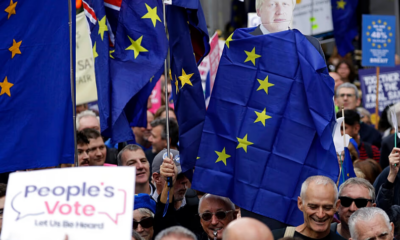Business
European Airline Stocks Drop After Heathrow Closure
Shares of major European airlines fell on Friday following the temporary shutdown of London’s Heathrow Airport, the busiest airport in the region, due to a power outage caused by a fire.
Heathrow Shutdown Causes Widespread Disruptions
The unexpected closure of Heathrow resulted in the cancellation of hundreds of flights, affecting hundreds of thousands of passengers. The incident was triggered by a fire at an electrical station about three kilometers from the airport, which not only knocked out power but also disabled the airport’s backup power supply. The fire was brought under control after seven hours, but the operational fallout was significant.
“We expect significant disruption over the coming days, and passengers should not travel to the airport under any circumstances until the airport reopens,” Heathrow officials said in a statement.
According to flight tracking service FlightRadar24, at least 1,350 flights to and from Heathrow were affected. The disruption hit airlines operating out of the airport particularly hard.
Airline Shares Plummet
British Airways, one of the most impacted airlines, confirmed that the outage had a “significant” effect on its operations. The airline, owned by International Consolidated Airlines Group (IAG), was forced to cancel all short-haul flights on Friday. IAG shares dropped 3% in early trading before recovering slightly to a 1.5% decline by early afternoon.
Russ Mould, investment director at AJ Bell, noted that investors appeared confident that the Heathrow issue could be resolved swiftly. However, the financial repercussions for airlines remain uncertain.
A British Airways spokesperson stated that the company was reviewing its long-haul flight schedule and evaluating the impact on future operations. The airline is offering affected passengers rebooking options or full refunds.
Financial Impact and Broader Market Reaction
Analysts at Jefferies highlighted that British Airways relies heavily on Heathrow, with weekend flights accounting for 0.4% of its projected 2025 available seat kilometers (ASKs). The investment bank warned that compensation payouts for canceled flights could cut up to 3% from IAG’s 2025 earnings before interest and taxes (EBIT). Additional costs for pilot and crew relocation are also expected to affect the company’s bottom line.
The disruption sent ripple effects through the airline industry. Shares of KLM-Air France dropped by 1.5%, Lufthansa declined by 1.7%, and EasyJet lost about 1% by mid-afternoon. Even airlines that do not operate from Heathrow were affected by the negative market sentiment, with Wizz Air falling 1.4% and Ryanair slipping 0.8%.
The downturn extended beyond airlines, with travel and tourism stocks also taking a hit. German tour operator TUI, which owns multiple airlines, saw its shares decline by 1.8%. Intercontinental Hotels Group, another key player in the travel sector, recorded one of the steepest losses on the London Stock Exchange, dropping 3.7%.
Ongoing Concerns in the Aviation Sector
The sell-off reflects broader investor concerns about the aviation industry’s outlook. Mould noted that IAG’s shares have declined by 25% from their five-year peak in February, citing worries over consumer and business travel demand amid economic uncertainty and ongoing trade tensions.
With Heathrow’s closure expected to cause lasting disruption, airlines and investors will be closely watching for further developments and the financial impact on the industry in the coming weeks.
Business
Silver Surges Past $60 as Supply Strains, Rate Expectations and Tariff Concerns Drive Rally

Silver prices have surged to levels not seen before, rising above $60 an ounce this week after months of rapid gains driven by tightening supply, shifting Federal Reserve expectations and uncertainty around potential US trade actions. The metal hovered near $62 on Wednesday, extending a rally that began early this year when prices averaged around $30.
The latest jump came ahead of the Federal Reserve’s meeting, where investors expect another cut to the benchmark interest rate. The timing of the central bank’s leadership transition has added another layer of speculation. The US administration is reviewing finalists to replace Jerome Powell as chair, with Kevin Hassett, a senior economic adviser during Donald Trump’s presidency, reported to be the leading contender.
Market analysts say the candidates under consideration favour sharper rate reductions than those overseen by Powell. Since September, the Fed has trimmed rates twice by a quarter point each time. The gentler pace of easing has already pressured returns on cash and fixed-income assets, prompting many investors to shift into precious metals, which typically attract interest when rates fall. Silver, which does not generate yield, becomes more appealing in such an environment. Its performance has even outpaced gold, which has risen about 60 percent this year to reach record highs.
At the same time, traders are monitoring signals from Washington about whether silver could be targeted with tariffs. The metal was added in early November to the US government’s 2025 Critical Minerals List, a classification usually applied to resources seen as essential for national economic security. The designation places silver within the range of potential Section 232 investigations, the mechanism used in past years to justify tariffs on imported steel and aluminium.
Section 232 allows restrictions on imports deemed to put the country at risk through heavy dependence on overseas supply. No investigation has been launched, and officials have not indicated that tariffs are imminent. Still, the possibility has unsettled markets. Any duties on imported silver could reshape trade patterns and raise costs for domestic manufacturers, leading some buyers to boost inventories as a precaution.
Industrial use is also adding upward pressure. Demand from electric vehicle and solar panel manufacturers continues to rise, with these sectors relying on silver for components essential to production. Industrial consumption represents more than half of global silver use, and the combination of tight supply and strong manufacturing needs has intensified the rally.
Analysts say the market remains highly sensitive to signals from the Fed and the White House, with both interest-rate policy and trade decisions poised to shape the direction of prices in the months ahead.
Business
US Allows Nvidia to Sell H200 Chips to Approved Chinese Customers With 25% Surcharge
Business
Gold Looks to 2026 After a Record-Breaking Year Marked by Geopolitical Tension and Strong Central Bank Demand
-

 Entertainment1 year ago
Entertainment1 year agoMeta Acquires Tilda Swinton VR Doc ‘Impulse: Playing With Reality’
-

 Business2 years ago
Business2 years agoSaudi Arabia’s Model for Sustainable Aviation Practices
-

 Business2 years ago
Business2 years agoRecent Developments in Small Business Taxes
-

 Home Improvement1 year ago
Home Improvement1 year agoEffective Drain Cleaning: A Key to a Healthy Plumbing System
-

 Politics2 years ago
Politics2 years agoWho was Ebrahim Raisi and his status in Iranian Politics?
-

 Business1 year ago
Business1 year agoCarrectly: Revolutionizing Car Care in Chicago
-

 Sports1 year ago
Sports1 year agoKeely Hodgkinson Wins Britain’s First Athletics Gold at Paris Olympics in 800m
-

 Business1 year ago
Business1 year agoSaudi Arabia: Foreign Direct Investment Rises by 5.6% in Q1





























